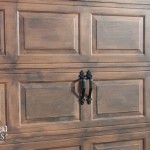How To Remove Oil And Grease Stains From Garage Floor Painted Wood
Garage floors are often exposed to a variety of substances, including oil and grease. These substances can create unsightly stains on painted wood floors, detracting from the overall appearance of the garage. Removing oil and grease stains from painted wood floors requires a specific approach to avoid damaging the paint. This article outlines the steps involved in effectively removing these stains while preserving the integrity of the painted surface.
Understanding the Challenge
Oil and grease stains are challenging to remove due to their nature. These substances are hydrophobic, meaning they repel water. Traditional cleaning methods involving water and soap may not be effective in dissolving and lifting oil and grease stains. Moreover, the porous nature of wood allows these substances to penetrate the surface, making removal even more difficult.
Painting the garage floor provides a protective layer, but it does not completely prevent oil and grease from penetrating the wood. The paint can become discolored or damaged if the cleaning process is not performed carefully. Understanding the characteristics of oil and grease stains and the limitations of painted surfaces is crucial for choosing the right approach.
Methods for Removing Oil and Grease Stains From Garage Floor Painted Wood
Several methods can be employed to remove oil and grease stains from painted wood floors. The effectiveness of each method may vary depending on the severity of the stain and the type of paint used. Here are some common options:
1. Using an Absorbent Material
One of the first steps in addressing an oil or grease stain is to absorb as much of the substance as possible. This can be accomplished using absorbent materials like paper towels, rags, or kitty litter. Apply the absorbent material to the stain and allow it to sit for several minutes. The material will absorb the excess oil or grease, reducing the amount that needs to be cleaned.
This method is particularly effective for fresh spills. However, for older stains, it may only remove a portion of the oil or grease. It is crucial not to rub the stain in the absorbtion process as this can spread the oil or grease and worsen the stain.
2. Employing a Degreaser
Degreasers are specially formulated products designed to break down and remove grease and oil. They are available in various forms, including liquids, sprays, and powders. For painted wood floors, it is essential to choose a degreaser that is safe for use on both the wood and the paint. Avoid using harsh degreasers that can damage the paint or wood.
To apply a degreaser, carefully follow the instructions provided on the product label. In most cases, you will need to apply the degreaser to the stain and allow it to sit for a few minutes. Then, gently scrub the stain with a soft-bristled brush. Finally, rinse the area thoroughly with clean water to remove any residue.
3. Using a Baking Soda Paste
Baking soda has mild abrasive properties that can help to lift oil and grease stains from painted surfaces. To prepare a baking soda paste, mix baking soda with a small amount of water to create a thick paste. Apply the paste to the stain and let it sit for at least 30 minutes.
After the paste has dried, gently scrub the stain with a soft-bristled brush. Rinse the area thoroughly with clean water to remove any remaining baking soda. This method is particularly effective for light to moderate stains. For heavy stains, you may need to repeat the process several times.
4. Utilizing a Commercial Stain Remover
Commercial stain removers are designed for a variety of stains, including oil and grease. These products often contain specialized ingredients that can effectively break down and remove stains. When using a commercial stain remover, it is crucial to follow the manufacturer's instructions carefully. Some products may require specific application methods or drying times.
Always test the product in an inconspicuous area of the floor before applying it to the stain. This will help ensure that the product does not damage the paint. After applying the stain remover, follow the instructions for cleaning and rinsing the area.
5. Seeking Professional Assistance
If the stain is particularly stubborn or difficult to remove, consider seeking professional assistance. Professional cleaners have access to specialized equipment and cleaning products that may be more effective in removing oil and grease stains from painted floors. They can also provide expert advice on the best course of action for your specific situation.
Before contacting a professional, it is helpful to provide them with as much information as possible about the stain, including its age, size, and the type of paint used on the floor. This information will help them to determine the most effective cleaning method.

How To Remove Oil Stains From Concrete Floors Family Handyman

How To Remove Oil Stains From Concrete Floors Family Handyman

How To Remove Oil Stains From Concrete Floors Family Handyman

How To Remove Grease Stains From Wood Doityourself Com

How To Clean Oil Off A Wood Floor Fresh Spills Stubborn Stains

How To Clean Garage Floors So You Can Eat Off It Bci
.jpg?strip=all)
5 Tips On How To Remove Paint Stains From Your Garage Floor Danley S Garages

Maintaining Garage Floor Tiles Creative Ideas To Remove And Prevent Stains
How To Remove Dirt Oil And Grease Off Your Floor

How To Clean And Maintain Floors Paradigm Concrete Finishes
Related Posts








